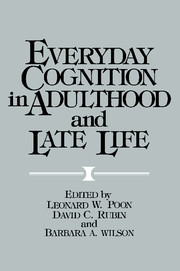Book contents
- Frontmatter
- Contents
- List of contributors
- Preface
- Part I Adult cognitive abilities in the laboratory and in real-life settings: Basic theoretical and methodological issues
- Part IA Systematic approaches to laboratory and real-world research
- Part IB Combining laboratory and real-world research
- Part II Cognition in adulthood and late life: Findings in real-life settings
- Part IIA Everyday cognitive abilities
- 11 Memory for prose: Perspectives on the reader
- 12 Prose processing in adulthood: The text, the reader, and the task
- 13 Speech comprehension and memory through adulthood: The roles of time and strategy
- 14 The effects of aging on perceived and generated memories
- 15 Aging and word retrieval: Naturalistic, clinical, and laboratory data
- 16 Acquisition and utilization of spatial information by elderly adults: Implications for day-to-day situations
- 17 Inner-city decay? Age changes in structure and process in recall of familiar topographical information
- 18 The cognitive ecology of problem solving
- 19 Everyday problem solving: Methodological issues, research findings, and a model
- 20 Prospective/intentional memory and aging: Memory as adaptive action
- Part IIB Concomitant influences
- Part III Cognitive enhancement and aging: Clinical and educational applications
- Part IIIA Issues and perspectives
- Part IIIB Enhancement approaches
- Part IIIC Designing programs for cognitive rehabilitation
- Subject index
- Author index
13 - Speech comprehension and memory through adulthood: The roles of time and strategy
Published online by Cambridge University Press: 05 October 2013
- Frontmatter
- Contents
- List of contributors
- Preface
- Part I Adult cognitive abilities in the laboratory and in real-life settings: Basic theoretical and methodological issues
- Part IA Systematic approaches to laboratory and real-world research
- Part IB Combining laboratory and real-world research
- Part II Cognition in adulthood and late life: Findings in real-life settings
- Part IIA Everyday cognitive abilities
- 11 Memory for prose: Perspectives on the reader
- 12 Prose processing in adulthood: The text, the reader, and the task
- 13 Speech comprehension and memory through adulthood: The roles of time and strategy
- 14 The effects of aging on perceived and generated memories
- 15 Aging and word retrieval: Naturalistic, clinical, and laboratory data
- 16 Acquisition and utilization of spatial information by elderly adults: Implications for day-to-day situations
- 17 Inner-city decay? Age changes in structure and process in recall of familiar topographical information
- 18 The cognitive ecology of problem solving
- 19 Everyday problem solving: Methodological issues, research findings, and a model
- 20 Prospective/intentional memory and aging: Memory as adaptive action
- Part IIB Concomitant influences
- Part III Cognitive enhancement and aging: Clinical and educational applications
- Part IIIA Issues and perspectives
- Part IIIB Enhancement approaches
- Part IIIC Designing programs for cognitive rehabilitation
- Subject index
- Author index
Summary
Comprehension of spoken language involves rapid construction of meaning from a transitory acoustic signal, the complexity of which can easily be overlooked. In ordinary conversation, speech rates may average between 100 and 180 words per minute (wpm), and a speaker reading aloud can easily average over 200 wpm. In addition, the words in spoken discourse often are unclear or garbled (Pollack & Pickett, 1963). In spite of these challenges, phonemic and syntactic structures interact with semantic and contextual contraints to produce the perception of an intelligible message in “real time” (Marslen-Wilson & Tyler, 1980). That is, unlike reading, in which the viewer may backtrack and proceed at a comfortable rate, speech is heard at the rate produced by the speaker. Not only must this complex acoustic signal be understood phonologically at this extraordinary rate, but also the utterances must be further analyzed into the sentences and propositional representations that give rise to meaning.
Whereas older adults often suffer from deficits in auditory processing (Olsho, Harkins, & Lenhardt, 1985), it has also been argued that they have particular difficulty with tasks requiring “deeper,” more effortful processing operations (Craik & Simon, 1980) and are slower in performing many cognitive operations (Salthouse, 1980, 1982). For these reasons, it might seem surprising that older adults are not more often noticed to have trouble in understanding everyday speech (e.g., in conversation, from television or radio).
Information
- Type
- Chapter
- Information
- Everyday Cognition in Adulthood and Late Life , pp. 195 - 221Publisher: Cambridge University PressPrint publication year: 1989
Accessibility standard: Unknown
Why this information is here
This section outlines the accessibility features of this content - including support for screen readers, full keyboard navigation and high-contrast display options. This may not be relevant for you.Accessibility Information
- 7
- Cited by
